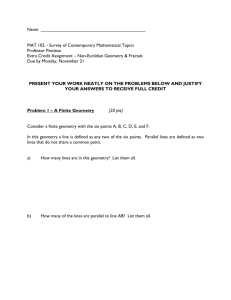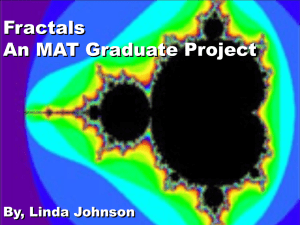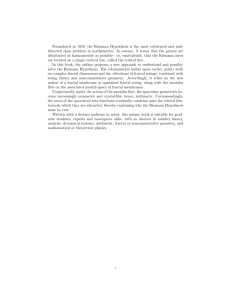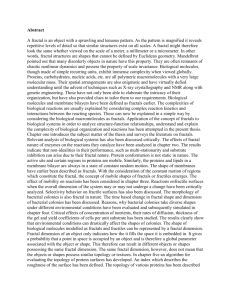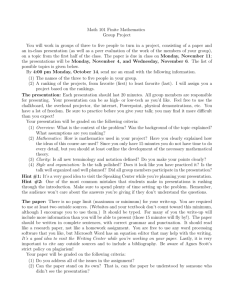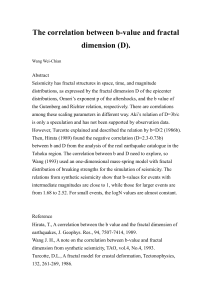christina Paper 2 Self-Organization and Society
advertisement
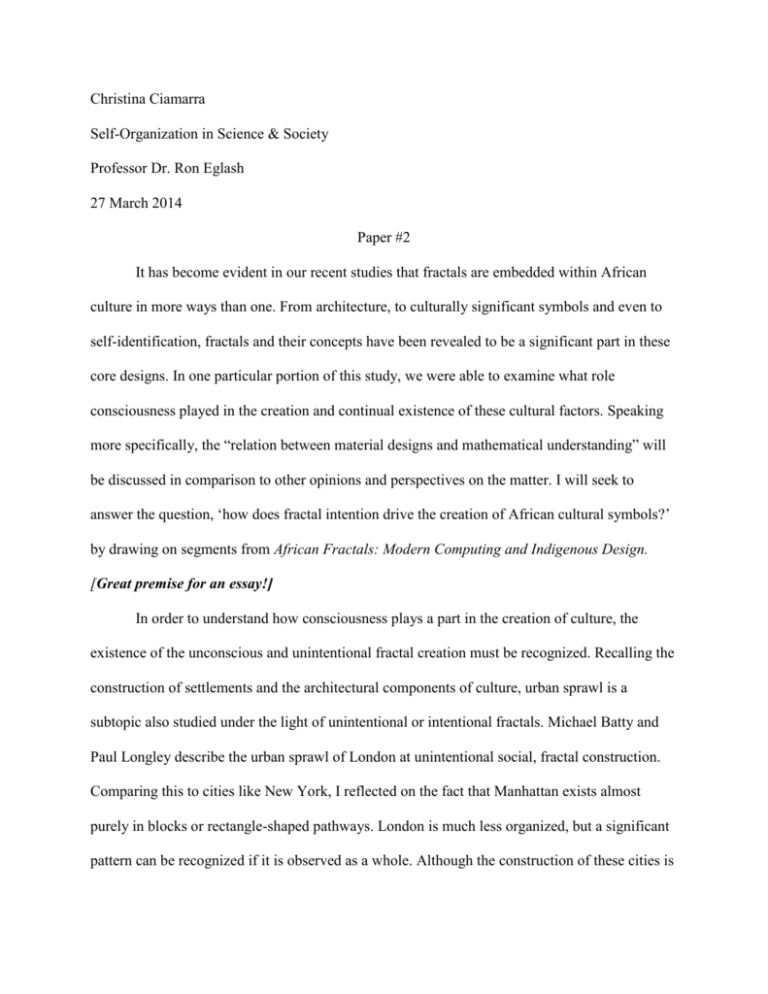
Christina Ciamarra Self-Organization in Science & Society Professor Dr. Ron Eglash 27 March 2014 Paper #2 It has become evident in our recent studies that fractals are embedded within African culture in more ways than one. From architecture, to culturally significant symbols and even to self-identification, fractals and their concepts have been revealed to be a significant part in these core designs. In one particular portion of this study, we were able to examine what role consciousness played in the creation and continual existence of these cultural factors. Speaking more specifically, the “relation between material designs and mathematical understanding” will be discussed in comparison to other opinions and perspectives on the matter. I will seek to answer the question, ‘how does fractal intention drive the creation of African cultural symbols?’ by drawing on segments from African Fractals: Modern Computing and Indigenous Design. [Great premise for an essay!] In order to understand how consciousness plays a part in the creation of culture, the existence of the unconscious and unintentional fractal creation must be recognized. Recalling the construction of settlements and the architectural components of culture, urban sprawl is a subtopic also studied under the light of unintentional or intentional fractals. Michael Batty and Paul Longley describe the urban sprawl of London at unintentional social, fractal construction. Comparing this to cities like New York, I reflected on the fact that Manhattan exists almost purely in blocks or rectangle-shaped pathways. London is much less organized, but a significant pattern can be recognized if it is observed as a whole. Although the construction of these cities is marked as unintentional, I argue that there was a certain degree of conscious organization to it. It cannot be said that Manhattan’s blocks were created with simple and mentally blind construction. (I regard ‘mentally blind’ as creating without direct conscious thought.) [glad to see you are thinking through this carefully—its interesting to see how our metaphors like “the mind’s eye” become models we take literally] Diffusion limited aggression doesn’t have to imply unconscious thought, in my opinion. Instead of understanding the concept with just unconscious thought, I propose that there could be two types of this social construction that describe either situation with conscious thought or unconscious thought. Figure 1: Google Satellite Capture of London Figure 2: Google Satellite Capture of Manhattan In support of the existence of conscious thought within fractal creation, many stories are written with a precise plot organization. Some examples of these stories were discussed earlier this semester, but pulling an outside example might reiterate the concept. Gone With the Wind is a classic novel known and read by many. I suspect that few people annotate the plot of the story enough to realize its fractal patterns. The story starts off with Scarlett O’Hara living as a young girl on her parents’ planation named Tara. With the many trials and tribulations that the civil war brings into her life, Scarlett’s character can be seen to have drastically changed by the end of the novel. After everything that has happened, she decides to return to Tara and start anew. This story comes full circle in Scarlett’s perspective, however, her character illustrates a much more experienced and dynamic one. In a way, we can understand her character to have grown, or in fractal terminology, scaled up. [I love the recursion concept here – not sure if scaling is the right metaphor to use – “she has a big heart”—“she gained a broader vision” – “she become a bigger person” – maybe it does work…. But you don’t need scaling to see the concept of recursion at work; there are other transformations you can apply.]. On the other hand, Scarlett’s return to Tara can be seen as another iteration of a pattern. Together, these to concepts form a rough image of a fractal within the story line simply because the magnitude of a unit has scaled up and reiterated. This could also be considered to be a nesting fractal, in a certain light. The point is, I doubt that Margret Mitchell unconsciously wrote the novel’s ending. I suggest that the plot seemed symmetrical or balanced in a way if Scarlett was to return her home after a major character change. If this is true, her thought process wasn’t completely unconscious of the pattern. There is this semi-consciousness that is exhibited in significant cultural artifacts like these stories. Despite this, I wouldn’t go so far to say that the concepts of fractal geometry were specifically incorporated in the creation of the stories’ plots. Though, I would say that there was an intention to create a dynamic and capturing plot by using patterns to structure it. There is a degree of consciousness in the creation of these stories, but there is little recognition or acknowledgement for fractal concepts. This unconscious versus conscious dynamic relates to another social construct as well. Visual representation is a major portion of personal identification and communication between others. Cornrows are deeply rooted in traditional African culture, yet modern society knows little about the origins of this cultural style. However, this conveys an example that exhibits unconscious thought in fractal construction. “It is possible to misread these examples of conformal mapping as being the product of artisans who are strongly guided by concrete forms rather than abstract thought,” (83). It is true that something with similar cultural significance as settlement structure can be completed with the opposite mindset. In the past, I theorize that cornrows were created in relation to the amount of hair in the braid. In other words, as the braid is created it becomes smaller and smaller as the hair on the head grows thinner in certain directions down the head. Scaling was a byproduct of the actual hairstyle construction, and possibly the fractal geometry as well. This can be related back to another visual domain: Art Nouveau. Figure 3: Art Nouveau Poster, Paris The image above illustrates how art nouveau battles with intentional fractals. Aimed to mimic nature, these pieces exhibited many floral and forest representations. Despite the goal of recreating nature, these pieces (like the one above) struggle to exclude rigid pattern and fractal concepts. The woman in the Paris poster adorns a circular pattern on the chest of her dress which is iterated in the background of the picture. Overall, one can pick out two to almost ten concentric circles within this one image. Another fractal concept displayed in this image is exhibited by the flowers. There are blossomed flowers on each of the small tree branches, but when zooming out is becomes evident that each tree is a flower on the branches that are rooted in the center focal point. Even though the idea behind mimicking nature implies a degree of natural randomness, this is a self-reference iteration that dabbles with semi-conscious fractal consideration. I call this semi-conscious fractal consideration for a couple of reasons. There is the possibility that the creator of the poster had some intent on balance within the image. Generally, it has been my experience that visuals become popular by the efficiency of their designs. Something just looks much more harmonious if the colors balance each other out, as well as the objects in the image. There is a strong balance represented in the art nouveau poster above, but I believe its fractals were made unintentionally. Therefore, my concluding theory on this case is that the design was meant to mimic nature while maintaining visual balance. As a byproduct, fractals became an essential factor. [Seems like there is room for considering an interplay of conscious and unconscious processes—you let your intuition tell you it is “unbalanced” but then its up to your conscious mind to decide what strategy to take to rebalance it. You might enjoy reading Pickerings work for this purpose.] Consideration for fractal geometry cannot be decided by a ‘yes’ or a ‘no’. Throughout the different kinds of examples mentioned, we have seen how something can have some consciousness or some unconsciousness. Either way, fractals can be a byproduct of unconscious thought in certain cases. It can be argued that this may be more common than not, I hesitate to label these cases as completely one side or the other. There may a certain natural tendency to lean towards a balanced pattern when trying to create something with little conscious thought. Relating themselves back to nature itself, fractals can be much embedded into biology. I wonder if fractals are affiliated with conscious intention due to this fact. Excellent work! Comments in the text, Grade = A Works Cited Art Nouveau. N.d. Paris. Web. 26 Mar. 2014. Eglash, Ron. African Fractals: Modern Computing and Indigenous Design. New Brunswick, NJ: Rutgers UP, 1999. Print. "London." Google Maps. N.p.: Google, n.d. N. pag. Print. "Manhattan." Google Maps. N.p.: Google, n.d. N. pag. Print.
